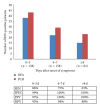Comparison of direct fluorescence assay and real-time rt-PCR as diagnostics for respiratory syncytial virus in young children
- PMID: 22220181
- PMCID: PMC3246791
- DOI: 10.1155/2011/781919
Comparison of direct fluorescence assay and real-time rt-PCR as diagnostics for respiratory syncytial virus in young children
Abstract
Respiratory syncytial virus (RSV) is the major cause of lower respiratory tract infections in children worldwide. Early detection of RSV is critical to initiate proper care. Two methods, the direct fluorescence assay (DFA) and the real-time reverse-transcription polymerase chain reaction (rt-RT-PCR), that are used for RSV detection were compared. A total of 451 nasopharyngeal aspirates from children 5 years of age or less were tested for RSV using both methods. The overall prevalence rate of the RSV among the children was 23.7% with a significantly higher prevalence among children under the age of 6 months of age when compared to other age groups. The sensitivity of DFA in comparison to rt-RT-PCR was highest (86%) during the first 3 days of symptoms onset and decreased gradually till it reached 65% after the first week. The specificity of DFA in comparison to rt-RT-PCR ranged between 99 and 100% irrespective of the date of collection. We concluded that, although the rt-RT-PCR is more sensitive for RSV detection, the DFA offers a reliable point-of-care alternative detection method especially during the first few days of illness.
Figures


Similar articles
-
[Detecting human respiratory syncytial virus in respiratory samples collected from children with acute respiratory infections by reverse transcription-loop mediated isothermal amplification].Zhonghua Er Ke Za Zhi. 2013 Apr;51(4):270-5. Zhonghua Er Ke Za Zhi. 2013. PMID: 23927800 Chinese.
-
[Clinical value of a rapid respiratory syncytial virus antigen detection in point-of-care testing].Zhonghua Er Ke Za Zhi. 2017 Feb 2;55(2):139-143. doi: 10.3760/cma.j.issn.0578-1310.2017.02.017. Zhonghua Er Ke Za Zhi. 2017. PMID: 28173654 Chinese.
-
Simultaneous detection of respiratory syncytial virus and human metapneumovirus by one-step multiplex real-time RT-PCR in patients with respiratory symptoms.BMC Pediatr. 2017 Mar 27;17(1):89. doi: 10.1186/s12887-017-0843-7. BMC Pediatr. 2017. PMID: 28347279 Free PMC article. Clinical Trial.
-
Detection of human metapneumovirus and respiratory syncytial virus by duplex real-time RT-PCR assay in comparison with direct fluorescent assay.Clin Microbiol Infect. 2010 Oct;16(10):1568-73. doi: 10.1111/j.1469-0691.2010.03191.x. Epub 2010 Feb 11. Clin Microbiol Infect. 2010. PMID: 20156219
-
Prospective evaluation of rapid antigen tests for diagnosis of respiratory syncytial virus and human metapneumovirus infections.J Clin Microbiol. 2008 May;46(5):1682-5. doi: 10.1128/JCM.00008-08. Epub 2008 Mar 12. J Clin Microbiol. 2008. PMID: 18337386 Free PMC article.
Cited by
-
Laboratory Diagnosis of Respiratory Tract Infections in Children - the State of the Art.Front Microbiol. 2018 Oct 18;9:2478. doi: 10.3389/fmicb.2018.02478. eCollection 2018. Front Microbiol. 2018. PMID: 30405553 Free PMC article. Review.
-
Molecular and Immunological Diagnostic Techniques of Medical Viruses.Int J Microbiol. 2020 Sep 4;2020:8832728. doi: 10.1155/2020/8832728. eCollection 2020. Int J Microbiol. 2020. PMID: 32908530 Free PMC article. Review.
-
Epidemiological and clinical profiles of respiratory syncytial virus infection in hospitalized neonates in Suzhou, China.BMC Infect Dis. 2015 Oct 15;15:431. doi: 10.1186/s12879-015-1155-x. BMC Infect Dis. 2015. PMID: 26470889 Free PMC article.
-
Respiratory Syncytial Virus: Infection, Detection, and New Options for Prevention and Treatment.Clin Microbiol Rev. 2017 Jan;30(1):277-319. doi: 10.1128/CMR.00010-16. Clin Microbiol Rev. 2017. PMID: 27903593 Free PMC article. Review.
-
Prevalence of respiratory syncytial virus infection among children hospitalized with acute lower respiratory tract infections in Southern India.World J Clin Pediatr. 2019 Apr 9;8(2):33-42. doi: 10.5409/wjcp.v8.i2.33. eCollection 2019 Apr 9. World J Clin Pediatr. 2019. PMID: 31065544 Free PMC article.
References
-
- Miller S. A community health concern: respiratory syncytial virus and children. Journal of Pediatric Nursing. 2010;25(6):551–554. - PubMed
-
- Reis AD, Fink MCD, Machado CM, et al. Comparison of direct immunofluorescence, conventional cell culture and polymerase chain reaction techniques for detecting respiratory syncytial virus in nasopharyngeal aspirates from infants. Revista do Instituto de Medicina Tropical de Sao Paulo. 2008;50(1):37–40. - PubMed
LinkOut - more resources
Full Text Sources

